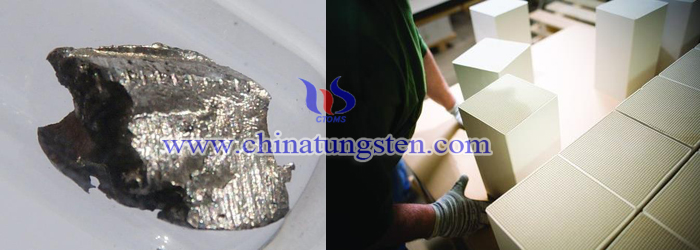Cerium-Titanium Based Tungsten Trioxide Denitration Catalyst
- Details
- Category: Tungsten Information
- Published on Tuesday, 24 May 2016 16:18
Cerium is the most abundant of rare earth in the crust, which is a silver active metal; its powder is easily spontaneous combustion in the air, soluble in acid. Metal cerium mainly used for reducing agent, catalyst, also as an alloy additive and the production of cerium salts. The current widespread use of SCR technology commonly use the tungsten trioxide or molybdenum trioxide vanadium pentoxide/titania-based catalyst, which is widely used in flue gas denitrification stationary sources, and also used in catalytic diesel exhaust NOx elimination.

In the running of vanadium-based catalyst, the toxic substance of V may shed to enter the environment, causing environmental pollution and human harm. In addition, vanadium trioxide denitration catalyst has relatively narrow operating temperature window; besides, sulfur dioxide is easily converted to sulfur trioxide in high temperature, thus to cause a secondary pollution. So, the development of high stability, wide temperature window, non-toxic catalyst for flue gas denitrification and stationary diesel exhaust NOx elimination, is always the hot topic in the field of environmental catalysis.
Studies have indicated that prepare tungsten trioxide doped of cerium-titanium based denitration catalyst by co-precipitation method, shown as follows:
1. Take cerium nitrate, ammonium tungstate and titanium sulfate to prepare the well mixed solution of Ce/W/Ti by the molar ratio of 0.2 / 0.1 / 1.0;
2. Add urea solution, continually stir at a temperature of 90°C for 12 hours, followed by filtration and washing;
3. Drying the filter cake in the oven at 100°C overnight, transferred into the muffle furnace for calcining at 500°C in the air;
4. Molding to give the desired cerium- titanium based tungsten trioxide denitration catalyst.
The denitration catalyst has no toxic substance of vanadium that means no threat to human health and the environment; in addition, it has a wide operating temperature which is not only suitable for large variations in temperature of motor vehicle exhaust, but also for stationary sources of flue gas denitrification, making it have good prospects.
| Tungsten Oxide Supplier: Chinatungsten Online www.tungsten-oxide.com | Tel.: 86 592 5129696; Fax: 86 592 5129797;Email:sales@chinatungsten.com |
| Tungsten News & Prices, 3G Version: http://3g.chinatungsten.com | Molybdenum News & Molybdenum Price: http://news.molybdenum.com.cn |



 sales@chinatungsten.com
sales@chinatungsten.com